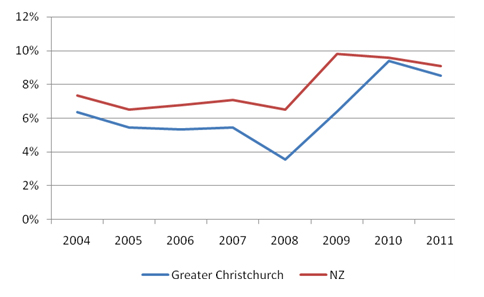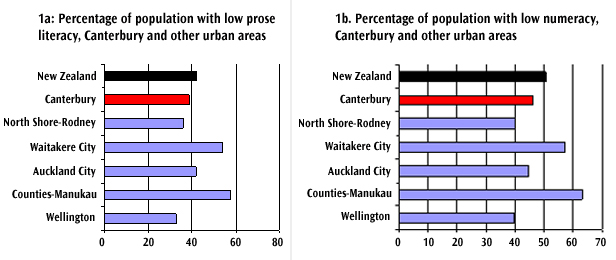Education prior to the earthquakes
What did the education system look like prior to the earthquakes
- The labour market had a profile similar to that of New Zealand as a whole, but without the high-skill profile characteristics of the other main metropolitan areas.
- Before the earthquakes, there were more employed and less unemployed that the national average.
- The performance of the education system was broadly similar to that of New Zealand – there was no evidence of systemic underperformance.
- School leaver attainment was, however, behind that of Auckland and Wellington.
- The outflow from advance tertiary programmes had tended to provide people with skills into work in other areas of New Zealand, principally Auckland and Wellington.
- In 2010, a slightly higher percentage of school leavers in Christchurch City achieved NCEA level 2 or above than the New Zealand average. However, the system was not working well enough for Māori students and Pasifika students, with only 44% of Māori and 53% of Pasifika achieving NCEA level 2 or above, both below the national averages for these student groups.
- A fifth (20%) of Canterbury 20 year-olds took no further part in the education and training system after leaving school – in the changing economy, this poses the risk a large number of people become disengaged.
- There are serious disparities by ethnic group – Māori and Pasifika have lower school achievement than others. Given school performance is the most powerful predictor of success in tertiary education, Māori and Pasifika are over-represented among those disengaged and at risk of further disengagement.
Youth unemployment in Canterbury – latest data
The number of 15-24 year-olds not in employment, education or training (NEET) in the region fell by 13% to 6,800 between June 2010 and June 2011.
The fact the number of 15-19 year-olds in formal education went up is one of the overall reasons the overall NEET rate has fallen, despite the increase in the rate for 20-24 year-olds.
That’s a percentage decrease of 9.4% to 8.5%.
Nationally, this fell from 9.6% in June 2010 to 9.1% in June 2011.
The apparent improvement in greater Christchurch is magnified by the drop in the youth population in the region, with the number of 20-24 year-olds falling by more than 6,000 between June 2010 and June 2011.
Taken in isolation, the data for 20-24 year-olds also shows the percentage of NEETs in this age group has deteriorated when compared with the rest of New Zealand. The percentage of people aged 20-24 who are NEET in Christchurch rose from 10.6% to 12.2% between 2010 and 2011, while in New Zealand as a whole, there was a fall from 11.6% to 10.6%. The trend is illustrated in Figure 2.
Data from the Ministry of Social Development also indicates the number of people aged 24 or under on the Unemployment Benefit increased by 15% in the year to July 2011.
The table below gives the participation rate in education of 15-19 year-olds as calculated from the June Household Labour Force Survey data.
| 2009 | 2010 | 2011 | |
|---|---|---|---|
| School participation rate | 47% | 45% | 50% |
| Formal education participation rate | 69% | 71% | 81% |
Table 1: Participation rate in formal education in greater Christchurch, June 2009-2011
Overall what we are seeing is:
- The number of people aged 15-24 who are NEET in the region fell between June 2010 and June 2011.
- Part of the fall is due to a drop in the number of 20-24 year-olds living in the area.
- There has also been more 15-19 year-olds staying in education.
- Despite a drop across New Zealand as a whole, there has been an increase in the percentage of 20-24 year-olds who are NEET in greater Christchurch.
Skill profile in Canterbury
Around 38% of those aged 25-65 in Canterbury have low1 level literacy and around 47% have low numeracy.
While these are slightly better than the proportions in New Zealand as a whole, the population in Canterbury has lower skill levels than Auckland or Wellington.
The population is less well qualified than the country as a whole. In the 2006 Census:
- there was a higher proportion of people in Canterbury with no qualifications
- there was a higher proportion in Canterbury whose highest qualification was a school qualification
- there was a lower proportion in Canterbury who held a degree or higher.
The qualifications profile graph below shows Canterbury people are more likely than the country as a whole to have trades or school qualifications, but less likely to have a degree or higher.
Figure 4: Educational attainment of the workforce, Canterbury vs. New Zealand, 2006
The proportion of people working in occupations associated with higher skills is slightly higher than the national figure2 but not significantly so.
Average hourly earnings have been between 94% and 96% of the national hourly earnings over the last two years.
The data suggests the Canterbury region has a labour market that is broadly typical of New Zealand as a whole, but that does not have the high-skill profile of the Auckland and Wellington economies where the most knowledge-intensive industries tend to be located.
1 Low skills, in this context, are those whose skills result in a classification of level 1 or 2 on a five-point scale, where level 3 is considered adequate for full participation in a modern, knowledge-based economy.
2 Lane C (2010) Adult Literacy in New Zealand: a regional analysis, Ministry of Education. Lane establishes that computer use is a better proxy for high skill by occupation than traditional classifications that use occupation names.



